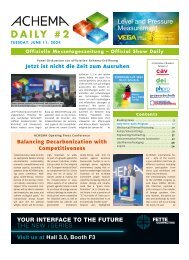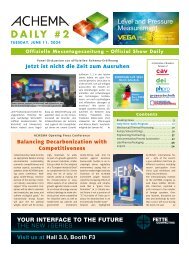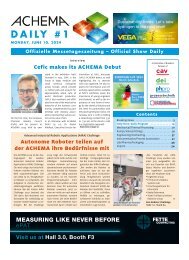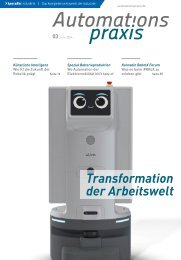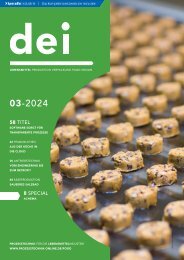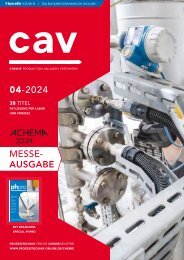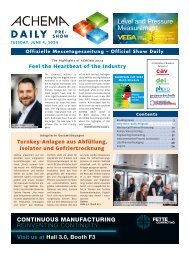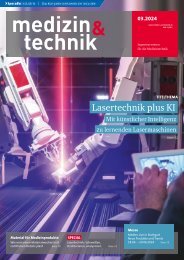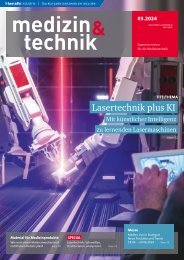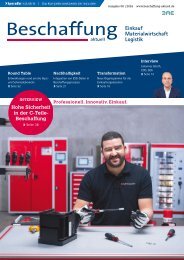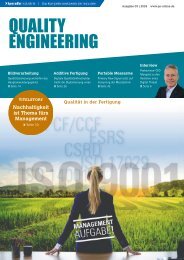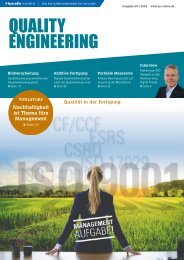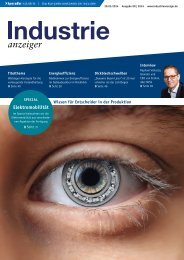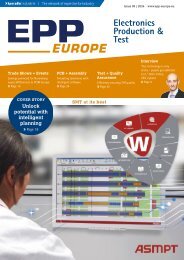cpp – Process technology for the chemical industry 01.2019
The journal cpp - Process technology for the chemical industry reports about processes, plants, apparatus and components for the chemical and pharmaceutical industry. Further topics are IT technologies, industry 4.0, digital production, MSR and automation technology and process analysis technology. The content spectrum is rounded off by explosion protection, plant safety, occupational health and safety, maintenance, site management and energy management.
The journal cpp - Process technology for the chemical industry reports about processes, plants, apparatus and components for the chemical and pharmaceutical industry. Further topics are IT technologies, industry 4.0, digital production, MSR and automation technology and process analysis technology. The content spectrum is rounded off by explosion protection, plant safety, occupational health and safety, maintenance, site management and energy management.
You also want an ePaper? Increase the reach of your titles
YUMPU automatically turns print PDFs into web optimized ePapers that Google loves.
The ContiTDS is set up outside of <strong>the</strong> container. It moves <strong>the</strong> liquid in a<br />
cycle and suctions <strong>the</strong> powder in a dust-free manner.<br />
<strong>Process</strong> plant <strong>for</strong> processing dust-Ex powders<br />
installed outside <strong>the</strong> process tank, recirculates<br />
<strong>the</strong> liquid in a loop and inducts it dustfree.<br />
The machine can work with significantly<br />
higher viscosities, different batch<br />
sizes and variable liquid levels in <strong>the</strong> tank. It<br />
can be set up separately from <strong>the</strong> process<br />
tank or connected to multiple tanks.<br />
Both machines are designed and certified in<br />
accordance with <strong>the</strong> relevant dust and gas<br />
explosion directives; <strong>the</strong>y use only certified<br />
components and are suitable <strong>for</strong> both dust<br />
and gas explosive atmospheres. The systems<br />
are available with different Atex classifications<br />
as well as with IEC Ex and NEC certifications.<br />
<strong>Process</strong>ing in non-explosive areas<br />
One unique variation is designed <strong>for</strong> users<br />
who need to process dust explosive<br />
powders in non-ex-classified zones. This application<br />
is rare in <strong>the</strong> <strong>chemical</strong> <strong>industry</strong><br />
but common in food, cosmetics and pharmaceutical<br />
production, where a large<br />
number of organic powders with <strong>the</strong> potential<br />
to <strong>for</strong>m explosive dusts are processed.<br />
Dust explosion risks outside <strong>the</strong> processing<br />
systems can be prevented by taking suitable<br />
precautions. Inside <strong>the</strong> system, however,<br />
critical explosive dust atmospheres may be<br />
created shortly be<strong>for</strong>e <strong>the</strong> powder enters <strong>the</strong><br />
liquid. Suitable TDS machines are available<br />
<strong>for</strong> here; <strong>the</strong>y are internally fully dust-explosion<br />
safe and classified. But externally<br />
<strong>the</strong>y are designed <strong>for</strong> installation in non-ex<br />
areas. A typical Ex classification is II 2D/ <strong>–</strong><br />
cT200 °C, where <strong>the</strong> zone specification be<strong>for</strong>e<br />
<strong>the</strong> dash applies to <strong>the</strong> interior zone<br />
and execution, and <strong>the</strong> specification after<br />
<strong>the</strong> dash <strong>for</strong> exterior zone. These machines<br />
can be used to process dust explosive<br />
powders in non-ex classified areas.<br />
Hoods can’t solve <strong>the</strong> problem<br />
Stainless steel covers <strong>for</strong> electric motors or<br />
even entire machines which are very popular<br />
in <strong>the</strong> food and pharmaceutical industries<br />
are extremely dangerous in explosive<br />
applications. Atex permits <strong>for</strong> motors and<br />
o<strong>the</strong>r electrical operating devices generally<br />
apply to temperatures between -20 and<br />
+40 °C. Measurements on pumps and o<strong>the</strong>r<br />
aggregates have shown that, even if <strong>the</strong><br />
hood over a motor has a relatively open design,<br />
temperatures of 60 or 80 °C are not<br />
uncommon. The temperature inside <strong>the</strong><br />
cover must <strong>the</strong>re<strong>for</strong>e be monitored and<br />
must not exceed 40 °C during operation;<br />
o<strong>the</strong>rwise, <strong>the</strong> ex-certification <strong>for</strong> any electrical<br />
components inside is no longer valid.<br />
The same is basically true <strong>for</strong> noise insulation<br />
hoods, although <strong>the</strong>se are significantly<br />
better insulated and sealed than<br />
simple cover hoods.<br />
In order to use hygienic covers and sound<br />
insulation in explosive areas, <strong>the</strong> hoods<br />
must have interior cooling. Internal cooling<br />
systems are often insufficient due to <strong>the</strong> limited<br />
cooling surface. In this case, a temperature-controlled<br />
ventilation is <strong>the</strong> only<br />
alternative.<br />
www.<strong>cpp</strong>-net.com<br />
Online search: <strong>cpp</strong>0119ystral<br />
Hall 3, Booth 431<br />
AUTHOR:<br />
DR. ING. HANS-<br />
JOACHIM JACOB<br />
<strong>Process</strong> and Application<br />
Engineering,<br />
Ystral<br />
<strong>cpp</strong> 01-2019 15



